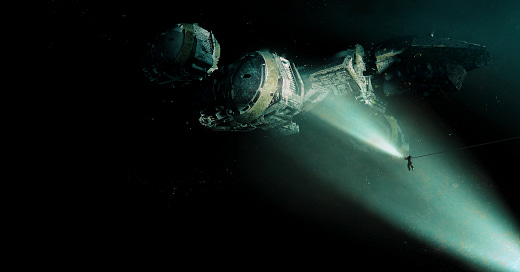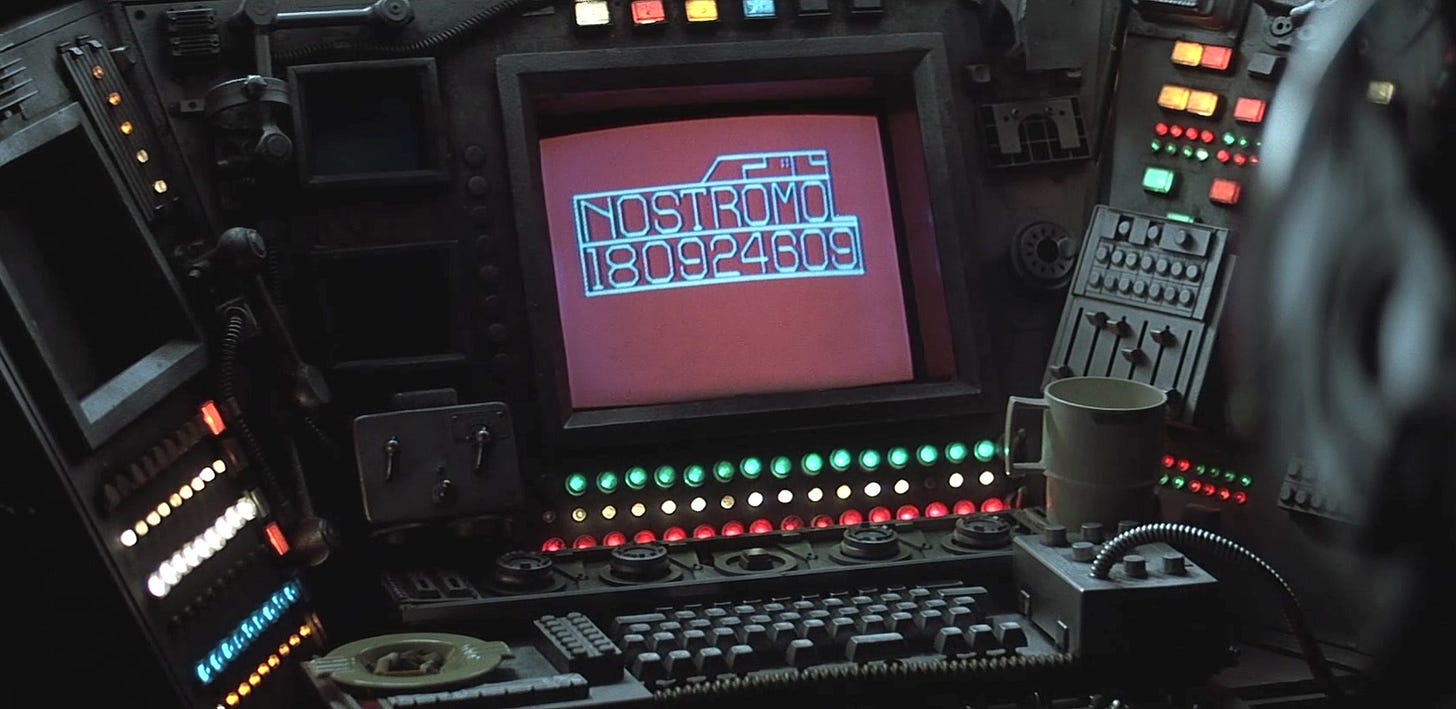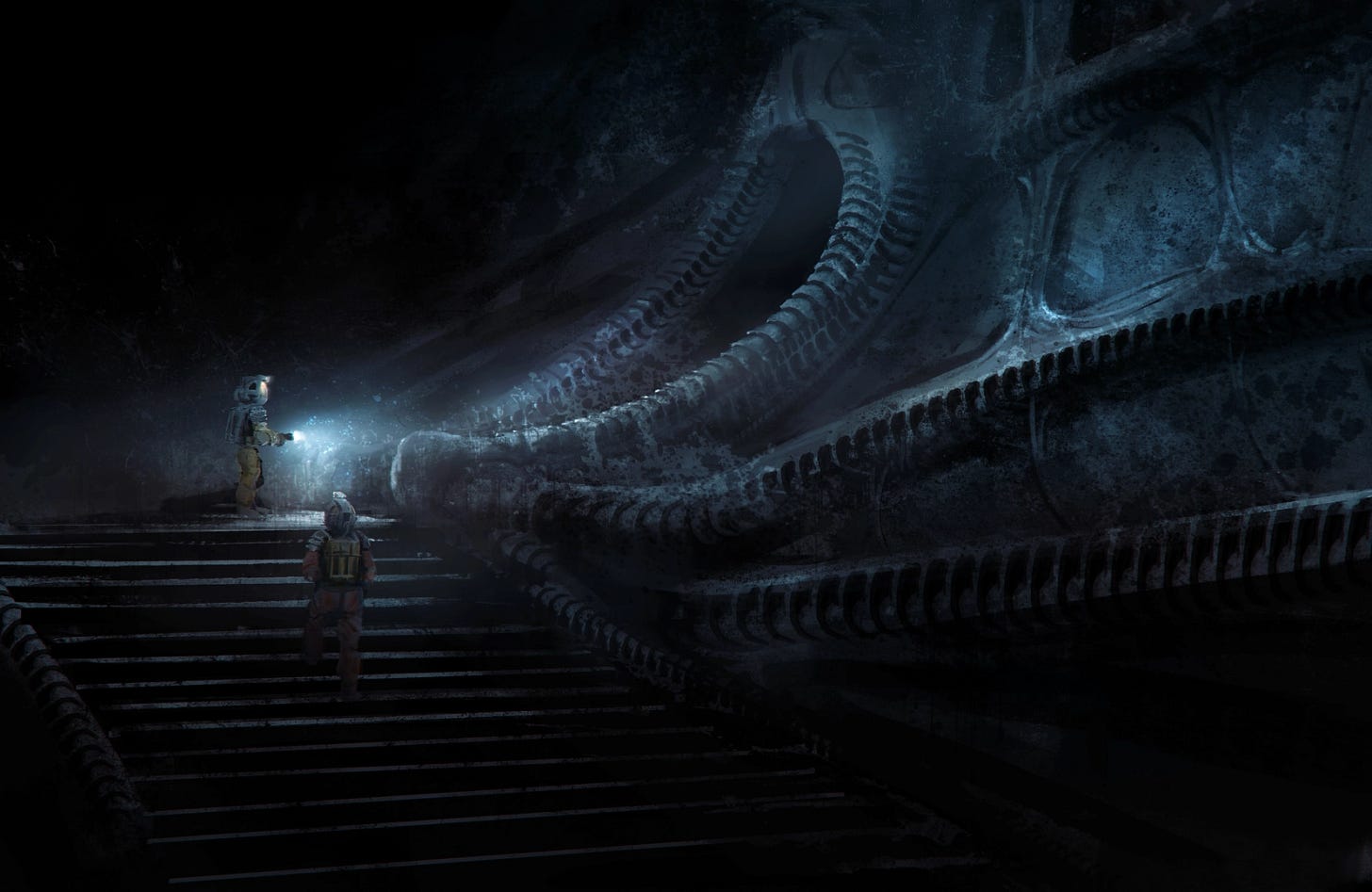Mega-review: The Alien RPG
Thoughts , criticism, and advice for running the Alien RPG and its modules.
Over the past year and a half, I have run Chariot of the Gods (CoG), Destroyer of Worlds (DoW), and the Colonial Marines Operations Manual (CMOM) in its entirety. Generally speaking, it was my first time DMing anything. Most of my experience here is with sci-fi action. Here are my thoughts.
Art by Martin Grip, Gustaf Ekelund, and Jarek Kubicki from The Colonial Marines Operation Manual.
The Books
The Verdict: Form triumphed over function. The books are great to read but horrible to use at the table.
If you're the kind of person that also enjoys L O R E, these are the books for you. They're dense with obscure Alien ephemera, including the silly 80s toys and the supremely 90s Dark Horse comics. Some elements work better than others. Despite the uneven source material, the author Andrew Gaska collated this stuff into a setting that is relatively consistent and keeping in spirit with the films. The glue that holds it all together though, is William Gibson's unproduced Alien3 screenplay, which establishes the forever cold war. That being said, unless your players are genuine Alienheads that will lap this stuff up, most of this L O R E is for the DM's enjoyment. When preparing to run one of these modules, cherry-pick the relevant details, set the scene, and get to the action. Listening to the DM read a dossier is not fun.
One pitfall to avoid if you've never run a sci-fi game before: consider how technology works and how your rulings will affect everything. How does FTL work? How long does it take to beam a transmission across the network? Is a transmission all or nothing? Can it be interrupted or intercepted? Just how all-powerful is MU/TH/UR? Do you have to be at her core to interface with her, or can you issue a self-destruct command from the terminal in the cargo bay? Can a nuke really break like that? Some of these questions have concrete answers, but many are up to interpretation. Or, these things may never come up at your table, and this may be an issue unique to mine. My players are hard-scifi nerds and nuclear enthusiasts—I'm not.
Presentation
These books have incredible and consistent art direction across the entire line, thanks to Martin Grip, John R. Mullaney, Axel Torvenius, Gustaf Ekelund, and Jarek Kubicki. The art is moody and evocative; respectably austere at times but leaps off the page at others. Landscapes are thick with a miserable haze and steel corridors are ripe with Cameron blue tints—it just feels right. Everything that needs or benefits from an illustration has one. Page layouts, while sensible, tend to scatter important information across a few pages when one might suffice. If you want to run these modules, prepare to take extensive notes.
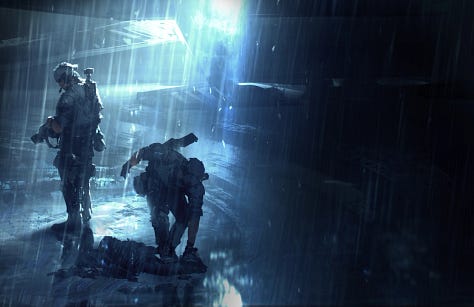
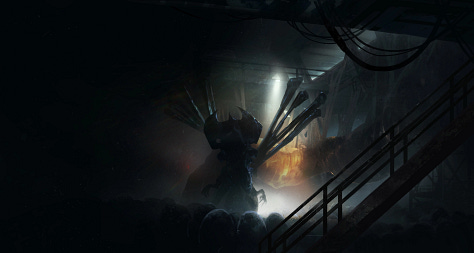
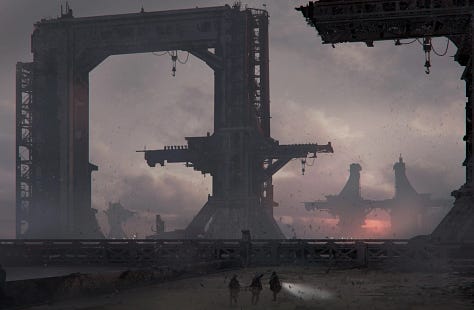
Art by Martin Grip and Gustaf Ekelund from the Core Rulebook and Destroyer of Worlds.
The System
Rolling Dice
The Verdict: The system is fun and intuitive, but not well suited for high level PCs or campaign play.
The Free League dice pool mechanic is super intuitive and the use of the Stress stat—which increases with each point of damage or horrific revelation—adds tactical risk/reward gameplay. In Alien, you roll a number of d6 equal to the Ability + Skill + Stress level of a character, further modified by equipped weapons and talents. Any rolled six is a success, and any additional sixes grant you stunts, which are flourishes for your actions. Any rolled one induces a Panic Check modified by the Stress level, which increases the chance of a severe reaction. The more your adrenaline is pumping, the better you perform. At least in theory.
Towards the back half of my CMOM campaign, my players had accrued so many dice in their pool that they rarely failed any roll, even without stress. Talents like Overkill—which negate any serious Panic effect—and the availability of stress-removing drugs blunted the entire panic mechanic. The lower levels are noticeably more exciting due to the higher chance of failure, reinforcing the "fail forward" narrative pace required of horror games. That noticeable plateau of success lends the system more towards its Cinematic modules, which stick to low level characters.
Combat
Art by Martin Grip, Gustaf Ekelund, and Jarek Kubicki from the Colonial Marines Operations Manual.
The Verdict: Don't pull any punches because the PCs are not as fragile as you'd expect, and unless keeping strict time and resource records is your strength, this game is best suited for sci-fi action.
Actions in combat are split into two categories: fast and slow. On your turn, you make one of each, or two fast actions. A limited and universal pool of actions makes combat punchy, and allows you to run way more combatants than you might think. I was using FoundryVTT's great initiative tracker though, so your mileage may vary.
Do not be afraid to pile on the enemies.
The PCs have three huge advantages over the NPCs: talents, armor piercing, and the broken status.
First: there is a talent meta that will turn your character into a god of war. Particularly Overkill, which negates any of the bad panic rolls and instead "forces" you to hold the trigger until everything in sight is dead. Combine that with Machine Gunner, which removes the stress increase on full-auto fire, and Rapid Reload, which makes reloading a fast action, and you are unstoppable.
Second: when I first read the rules, the efficacy of Armor Piercing was not apparent to me. Every friendly gun has Armor Piercing, which halves an opponent's Armor Rating. The opposition does not enjoy this benefit, so by default, their attacks are half as effective. In my experience, a single fireteam of colonial marines can easily take on an entire squad of UPP infantry, and will annihilate any xenomorph that doesn't have the jump on them. A dozen morons with knives can actually carve people up pretty well, but they'll die as soon as the PCs get to react.
Lastly, the game's Broken condition—applied when you hit 0 HP—and the d66 critical injury table are a reliable safety net for PCs. Chances are they're not going to die, at least not instantly. Even fatal injuries are often easily treated in time to save their lives. The catch is that healing is only possible when you take a break in a safe area, of which there are almost none (good!)
Art by Martin Grip from the Core Rulebook.
While the system overall is elegant, there are a few exceptions to that. Unique and elaborate damage rules for acid splash, dehydration, disease, drowning, exhaustion, explosions, falling, fire, freezing, radiation, starving and suffocation, are a bit much. Not that most of these even came up at my table, but it's a pain in the ass to reference and keep track of. Movement is a little odd in this system. You can move freely within a zone that you are in, but crossing the border into an adjacent zone requires the use of the movement action. It's a little narratively unintuitive to freely move on a turn.
One final note. The Cutting Torch is legendary. Fear the torchbearer's flame. Any intelligent enemy should immediately try to bring them down.
Xenomorphs
Art by Martin Grip from the Core Rulebook.
Maybe my players were just lucky, but whenever I rolled for xenomorphs they got stomped. Armor Piercing guns and a weakness to fire means they're not quite as tanky as you might expect, and don't be fooled by "attacks with 10 Base Dice"—there's still a small chance that they will actually inflict serious damage. I stopped rolling for attacks entirely, and started picking them myself. Just be sure to telegraph any lethal moves. I pretty much never used the xeno critical injury table; too much bookkeeping.
Vehicles
Vehicle combat is great fun and easy to run. I highly recommend a PC take the Remote talent, which allows them to remotely pilot vehicles as an action. More combined arms encounters means bigger threats can be deployed. I recommend using some of my house rules to make vehicles more of a threat though.
The Modules
The Verdict: The modules are engaging, but could be pared down and tightened up during prep.
SPOILERS AHEAD // PLAYERS BEWARE
Chariot of the Gods
Art by Martin Grip from Chariot of the Gods.
Duration: 4 sessions (3-4 hours).
The first adventure in the 26 Draconis trilogy, followed by DoW—which spins off into CMOM—and HoD. Space truckers chance an encounter with a long lost ghost ship and pay a terrible price. CoG focuses on the horror pillar of gameplay and is pretty much just a derelict-crawl. Maybe I was just new but I wasn't able to find a good pace here, which I felt like it needed. If I were to rerun this, I would outline a clearer series of objectives, and focus on being really strict with air supply tracking. There's no reason this should be 4 sessions long.
Destroyer of Worlds
Art by Martin Grip and Gustaf Ekelund from Destroyer of Worlds.
Duration: 5 sessions (3-4 hours).
UA special forces search for AWOL marines with experimental bioweapons in their bellies—in an active warzone. The colony is being overrun by UPP regulars and insurgents while the brass attempts a full-scale evacuation using the space elevator.
By far my favorite module. It begins a crime procedural, followed by a ground invasion, and finally a spooky dungeon crawl. The way the narrative escalates between acts is 🤌. I have two tips for running DoW: Use all the events, but run them two, or even three, at a time. Second: Use the oil-eating bacteria liberally. If the outcome of a scene is starting to feel certain, radically alter the landscape. A fissure opens up and swallows a building hole, exposing the players' position or opening up a new flanking route. See what happens!
The Colonial Marines Operations Manual
Art by Martin Grip, Gustaf Ekelund, and Jarek Kubicki from The Colonial Marines Operation Manual.
Duration: Each Operation had a variable number of sessions (3-4 hours).
Operation Go Fish (3), Blaze of Glory (2) Dreamcatcher (1) Deep Shaft (1) Arcturian Apocalypse (2), Quiet Catch (1), Octopus Garden (1), plus an additional session (1).
Spinning out of the aftermath of DoW, CMOM takes a fireteam of colonial marines across the frontier to repel the UPP and investigate covert bioweapons programs. There are seven pre-written operations that can be run in any order—save for the last one—plus a number of prompts for unique side ops. They are varied, and utilize all the disparate aspects of the setting well. I used to think that (non-engineer) sentient aliens had no place in this series, but I really like what they've done with Arcturians here.
Something beautiful happened in my campaign. About halfway through, my players had gotten so pathogen-wary that their methods became as ruthless as the villain's, so they joined them. I gave them an unlimited budget, any item they wanted was theirs, and they could call down a berserker anytime they wanted (they never did). Adapting these missions to be played out from the villain's perspective was pretty easy, since they tend to be fighting over the same objectives.
Of course, when the full extent of their new commanding officer's plan was revealed, they had a change of heart. They deserted one of their fellow PCs—the psycho one—on a barren planet and triggered an army of Working Joes to tear him limb from limb. Then they hijacked their own Conestoga and flew off to thwart the nefarious scheme. Couldn't have hoped for a better turn of events.
Here is one tip for each operation (and my suggested mission order):
Go Fish: This is DoW Act II all over again. Run all the events at once and fill the sky with targets for their Particle Beam Phalanx.
Blaze of Glory: Let the players characterize the dropship crew, then kill one and wound the other in the descent, so they have to drag the survivor through the jungle. I was not able to find a good use for Dinh Ngoc Ha, but maybe you'll fare better.
Dreamcatcher: This mission is simple and goes sideways fast. Be generous to their attempts at stealth, but once shit kicks off, bust the Queen out ASAP.
Deep Shaft: I see no reason why the PCs wouldn't just kill everyone down there (see above: my players' heel turn). If you want to avoid that, give them a damn good reason to suspect they're not all infected. Or, play with gentler souls.
Arcturian Apocalypse: The Grand and Central Kivas were not the setpiece I was hoping for, and the nerve gas still lingering there doesn't really make sense. It should have dissipated long before the players get there. The real fun is down in the dark, with the apes. Great finale on this one, make it count.
Quiet Catch: My players beelined straight for the command center and ignored all the cool stuff hidden around the base, but I can't say I blame them. Consider some incentives for exploration.
Octopus Garden: Hit 'em with the storm. Pretty much nothing in the colonial rig matters except its function as an egress to the underground sections. Makes for a consistently good one shot and finale, but there was no setpiece highlight for me.
Advice and House Rules
Art by Martin Grip from the Core Rulebook.
Use as many of the events as you can, but combine them. Run two or three at a time.
Don't be afraid to throw a lot of enemies at the players. They can take it.
Secrecy is bad. It's better to give players too much information than too little, and it invites them to have fun with it—together. Play secret agendas in the open, and if they hack into the system, give them the camera feeds.
FoundryVTT makes tracking this game's initiative so much easier.
House Rules
Blast Power
Change: Blast Power is Armor Piercing and inflicts a minimum of 1 Damage.
The probability of doing any damage with Blast 9 sucks enough already, but when the damage is so easily negated by an armor roll, it feels like you're throwing firecrackers.
Vehicle Armor
Change: Any vehicle with an Armor Rating of 4+ can only be damaged by arms with 4+ damage or blast power.
This prevents APCs and helicopters from being shot down by small arms, but allows civilian vehicles to get turned to swiss cheese.
Naproleve
Change: One pill removes ½ stress and each additional pill taken within 24 hours only removes 1 stress.
These are tiny items, and any reasonably sized cache will have enough pills for your players to pop continuously for an entire module—no fun.
Pin Down (Talent)
Change: [...] NPCs' next slow action is replaced by a fast action.
This still prevents the opposition from attacking, but not from making a meaningful maneuver in its place.
Armat 37A2 12 Gauge Pump Action
Change: Armor Piercing at Engaged range.
I gather the design intention was to give this gun a niche—it plows through unarmored targets—but in practice it's just useless. This change still gives it a niche for the craziest bastards out there.


